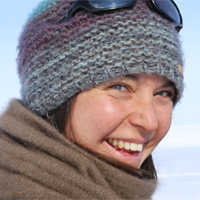Emilie Capron receives international Early-Career Scientist Award
Emilie Capron received the IUGG (International Union of Geodesy and Geophysics) Early Career Scientist Award for her outstanding research in Earth Sciences and her international research cooperation. She is currently employed at the British Antarctic Survey (UK), and works as a guest scientist at the Centre for Ice and Climate at the Niels Bohr Institute, University of Copenhagen. Her research aims to improve our understanding of global and regional climate dynamics over the past 150 thousand years. To do so, she uses climate and environmental records measured on Greenland and Antarctic ice cores and integrates them into a larger context by linking them to other climate archives.
Providing a global dimension to polar ice cores

Emilie Capron has been part of the last three field seasons at the international EastGRIP deep ice core drilling camp. Photo by Troels Mikkelsen.
“Ice cores are a unique archive to get information about the past evolution of polar climate and atmospheric composition, but if you want a comprehensive view of the Earth System and the forcing mechanisms, it is important to also look at complementary information from other natural archives and climate model simulations. For instance, we can look at marine sediment cores to get information about past changes in the ocean circulation or in sea level. Climate models are also key to test with physics-based tools, the mechanisms hypothesized from the data”, Emilie Capron explains.
The past provides clues about the future
Lately Emilie Capron has been working on reconstructing climate changes in the polar and sub-polar regions during a past warm time interval that occurred app. 125,000 years ago. Emilie Capron’s work has provided the first representation of the climate changes during this time period and it turns out there are similarities to what we believe the polar climate will look like at the end of our own century. Even though 125,000 years ago seems like a long way away, this work is thus extremely relevant for today. It provides a test bed to study the effect of a warmer-than today polar climate on critical parts of the Earth System such as the polar ice sheets, the ocean circulation and the global sea level. It is important for predicting how climate change may impact socio-economic and natural systems in the future.
A journey to future collaborations
With the prize comes financial support to travel and attend the 27th IUGG General Assembly that will be held in July 8-18 in Montreal (Canada). Emilie Capron has been invited to the award ceremony on Saturday 13 July 2019 and to give a talk in the session “Celebrating Early Career Scientists”. The IUGG General Assembly will cover a wide array of research fields in Earth and Space sciences. It will be a great opportunity for Emilie to further expand her interdisciplinary network.
What’s to come?

Emilie Capron looking through a thin section of ice from the NEEM ice core. Photo by Sepp Kipfstuhl
Emilie Capron is excited about the prospect of a future large-scale European research project that aims at obtaining a continuous record of climate and atmospheric greenhouse gas concentrations from a new ice core drilled in Antarctica. It aims to extend back to 1.5 millions of years, almost twice as old as the oldest ice core to date. This new ice core should provide in particular a unique record of the past changes in atmospheric CO2 concentrations thanks to measurements performed on the air trapped in the ice. Recovering a 1.5 million year ice core will tighten the constraints on the response of the Earth system over various timescales to future greenhouse gas emissions.
